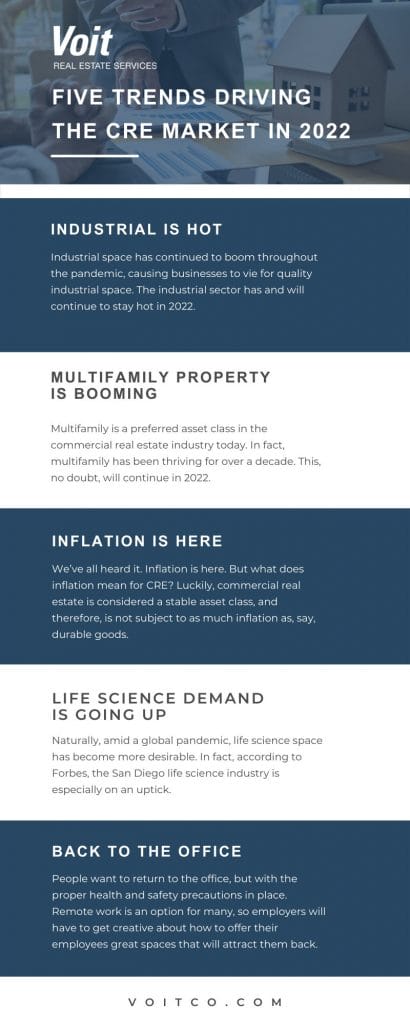
As we all well know, COVID-19 has continued to dominate headlines into 2022. The pandemic has changed how people conduct business, interact, shop, and live. This considered, there is no going back to what we once considered ‘normal.’ As with most industries, commercial real estate will continue to be affected.
In this article, we will detail five trends driving the CRE market in 2022. Let’s dive in.

Industrial is Hot
The industrial sector has and will continue to stay hot in 2022. In fact, in January, we wrote about how America’s warehouses are running out of space.
Industrial space refers to any commercial property used specifically for industrial purposes (warehousing, manufacturing, storage, logistics, showrooms, etc.).
Industrial space has continued to boom throughout the pandemic, causing businesses to vie for quality industrial space. Industrial vacancy rates hit a historic low of 3.6% in the third quarter of 2021 nationwide, according to Financial Times.
Research shows that this year, U.S. e-commerce sales will make up approximately 14.5% of total retail sales, or $709.78 billion.
This percentage will grow to 18.1% of all retail sales by the end of 2024, with online sales exceeding $1 trillion for the first time.
By 2025, U.S. demand for industrial CRE could reach an additional 1 billion square feet.
Multifamily Property is Booming
In addition to industrial, multifamily is a hot asset class in the commercial real estate industry today.
Today, multifamily properties are more than just bedrooms and bathrooms. Tenants pay for and expect to have access to amenities, including fitness centers, pools and spas, restaurants, usable office space, the list goes on.
This list of amenities, however, has shifted due to COVID-19. A majority of the population has experienced remote work, with many not returning to the office indefinitely. This considered, multifamily property owners will need to tailor their buildings to best fit these tenants’ needs as well.
Moreover, multifamily has been thriving for over a decade. This, no doubt, will continue in 2022. Read on for more about the evolution of multifamily property.
Inflation is Here
We’ve all heard it and can see it in daily life. Inflation is here.
But what does inflation mean for commercial real estate? Luckily, commercial real estate is considered a stable asset class, and therefore, is not subject to as much inflation as, say, durable goods.
Investing in commercial real estate can act as a hedge against inflation during this time, but more on that in our article, “What Does Inflation Mean for Your CRE Asset?”
Life Science Demand is Going Up
Naturally, amid a global pandemic, life science space has become more desirable. In fact, according to Forbes, the San Diego life science industry is especially on an uptick.
Second-ranked to Boston in dollars per venture capital transaction, the San Diego life science industry produces $41 billion in economic activity and accounts for approximately 68,000 jobs.
It’s important to remember, however, that although investment in lab space has increased, developing life science real estate is risky and takes huge amounts of capital with improvements for new space over $250 per square foot.
The teams necessary to transition traditional commercial buildings to labs are few and far between. Additionally, the specific requirements of lab space, including fitting issues and zoning prerequisites prove difficult to overcome.
Read on to learn more about how San Diego’s life science demand is heating up.
Back to the Office
What does the future hold for office space? The bottom line: People want to return to the office, but with the proper health and safety precautions in place.
Additionally, employers will have to get creative. With remote work as an option for many individuals, businesses “need to think creatively about how to offer their employees great spaces that will attract them back to the office to work in a collaborative environment,” according to the Los Angeles Times.
Although the need for office space has decreased throughout the global pandemic, there are main aspects of commercial real estate that stayed relatively stable. According to an article by Forbes, this includes: “warehouses for e-commerce, self-storage facilities, and certain retail spaces for grocery stores and pharmacies.”
Read on to learn more about what the future holds for office space.
A Final Word
As we’ve well learned over the past two years, nothing is 100% predictable. Regardless, it’s still a valuable practice to analyze current CRE trends and see where they might wind up. Read on for more 2022 commercial real estate predictions.